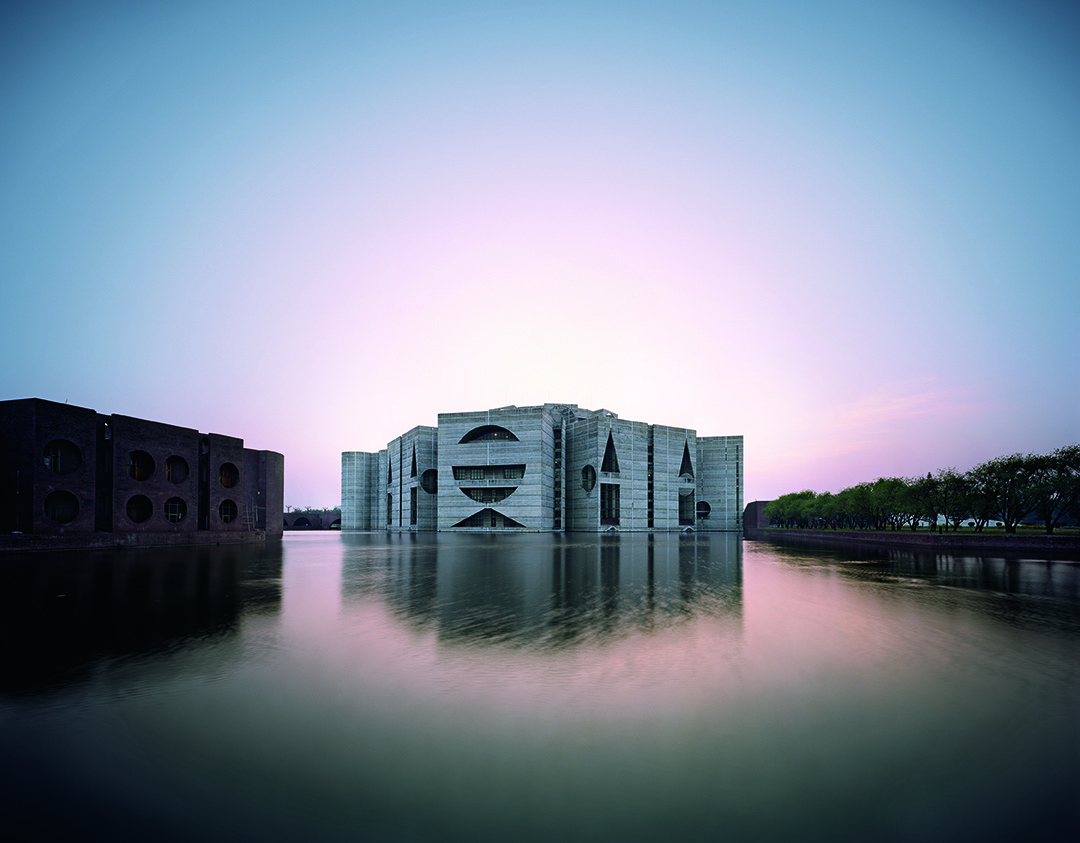Philadelphia, PA—The Fabric Workshop and Museum (FWM) is proud to present Louis Kahn: The Power of Architecture (August 11 – November 5, 2017). Organized by the Vitra Design Museum, Weil am Rhein, Germany, this landmark exhibition represents the first major retrospective of Kahn’s work in twenty years. Through more than 200 objects and ephemeral items, The Power of Architecture offers new insight into the famed architect’s methods and inspiration. The only East Coast venue for this momentous show, FWM is also the final stop on its international tour.
Louis Kahn, who spent most of his life and distinguished career in Philadelphia, is regarded as one of the greatest master builders of the twentieth century. With complex spatial compositions and a choreographic mastery of light, Kahn created buildings of archaic beauty and powerful universal symbolism. Among his most important works are the Salk Institute in La Jolla, California (1959-65), the Kimbell Art Museum in Fort Worth, Texas (1966-72), and the National Assembly Museum Building in Dhaka, Bangladesh (1962–83).
“We are thrilled to bring The Power of Architecture to Kahn’s hometown of Philadelphia,” says FWM Executive Director Susan Lubowsky Talbott. “This exhibition offers unprecedented insight into his artistic vision and process, very much in line with the mission of The Fabric Workshop and Museum. We, like Kahn, push the boundaries of possibility and experimentation in art and design.”
The exhibition encompasses an unparalleled and diverse range of architectural models, original drawings, photographs and films. All of Kahn’s important projects are extensively documented—from his early urban planning concepts and single-family houses to monumental late works such as the Roosevelt Memorial in New York City (1973/64), posthumously completed in October 2012.
The opening reception for The Power of Architecture is on Wednesday, September 6, 2017 from 6:00–8:00 pm in collaboration with the Center for Architecture and Design at 1218 Arch Street.
The Exhibition
The importance of Philadelphia to Kahn’s work is explored in the biographical introduction to The Power of Architecture and in the first of six thematic sections (entitled “City”). Philadelphia, which became Kahn’s hometown after immigrating to the U.S. at the age of five, was a kind of laboratory for the development of his urbanistic and architectural principles. Highlights in these sections include photographs, drawings and ephemeral items from his Philadelphia office and unpublished film footage shot by his son, Nathanial Kahn, who also directed the award winning film, My Architect.
For the first time, Kahn’s architectural models and sketches are presented alongside a selection of watercolors, pastels and charcoal drawings created during his travels, which document his skills as an artist and illustrator. Drawings from Italy, Greece and Egypt reveal his engagement with architectural history and archetypical structures. Interviews with architects such as Frank Gehry, Renzo Piano, Peter Zumthor and Sou Fujimoto underscore the profound influence and ongoing significance of Kahn’s work.
Additional thematic sections— “Science,” “Landscape,” “House” and “Eternal Present”—illustrate the development of Kahn’s work over time and highlight his interest in art, the natural sciences and human behavior. Kahn’s increasing success as an architect was accompanied by the evolution of an architecture that was closely linked to the timeless foundations of traditional building, yet radically innovative and future-oriented from a technological and constructional standpoint. The culminating section of the exhibition, “Community,” demonstrates how essential the social significance of architecture was to Kahn, and how he derived new forms for public buildings from it.Kahn’s uniqueness lies in his synthesis of the major conceptual traditions of modern architecture—from the École des Beaux-Arts and the constructive rationalism of the nineteenth century to the Arts and Crafts movement and Bauhaus Modernism—enhanced by the consideration of indigenous, non-western building traditions. Kahn gained important impulses from architectural movements such as Metabolism or Brutalism. Kahn anticipated aspects of buildings that are highly relevant today, including a return to local resources and ‘soft’ factors such as air, light and water. He saw himself as part of a tradition that spanned thousands of years and understood architecture not only as a means of satisfying utilitarian needs, but as an instrument of artistic speculation and a means of contemplating nature, history and human community.
Related Programming
FWM will host several programs in conjunction with the exhibition, including: private tours (September 16, 2017) of two Kahn-designed residences led by Kahn expert William Whitaker, Curator and Collections Manager of the Architectural Archives of the University of Pennsylvania School of Design; and a public lecture at the Center for Architecture and Design (November 2, 2017) featuring Kahn biographers Wendy Lesser and David Brownlee. In addition, the Museum will participate in DesignPhiladelphia (October 5 – 14, 2017), a ten-day festival highlighting Philadelphia’s reemergence as a 21st century city shaped by thoughtful design, collaborative business practices and community engagement. For more information on these and additional programs, please visit goo.gl/zgG8dx.

 Download the Press Release PDF
Download the Press Release PDF
